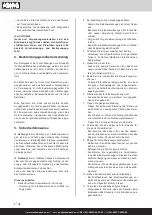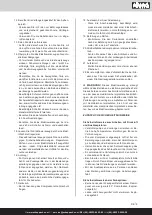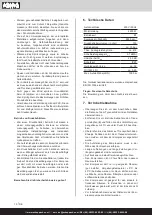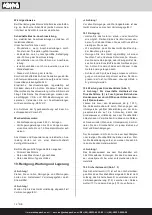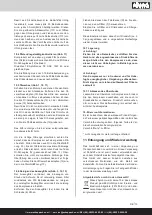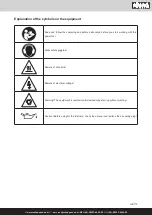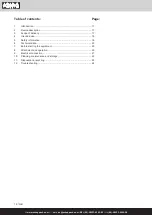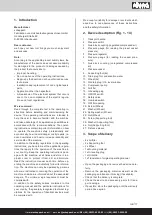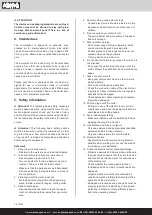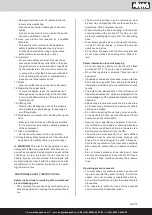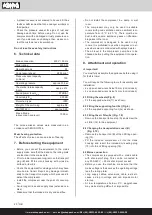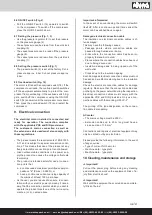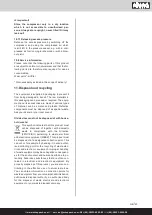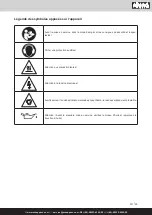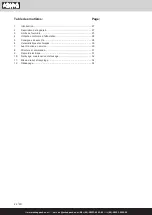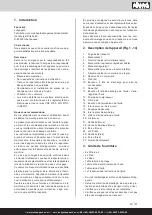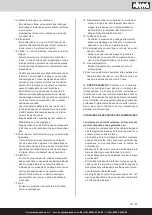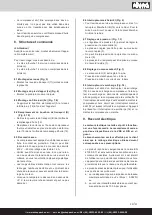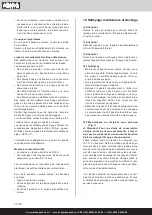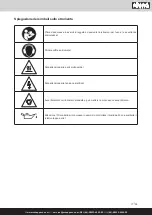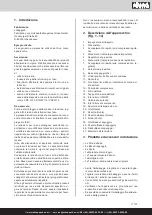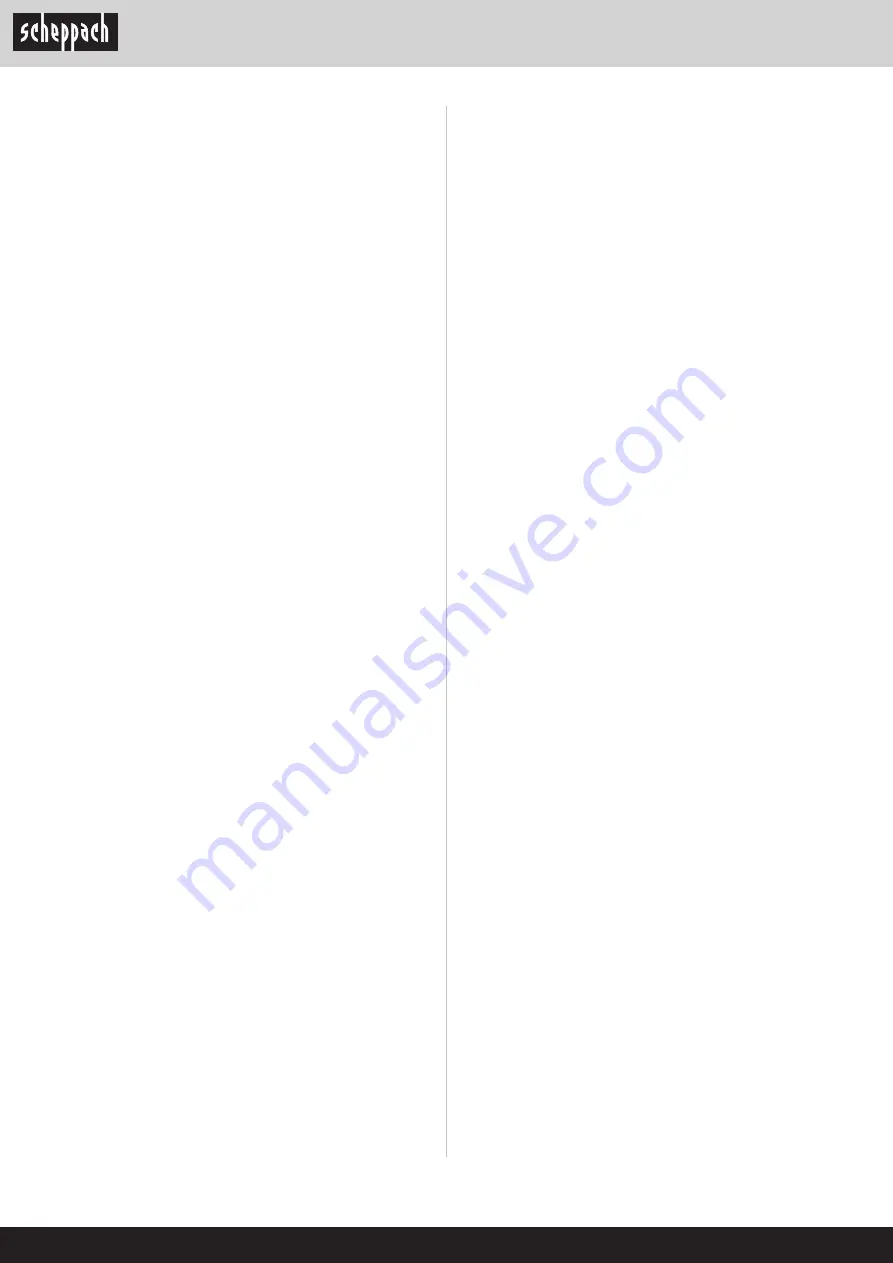
www.scheppach.com /
service@scheppach.com /
+(49)-08223-4002-99 /
+(49)-08223-4002-58
22 | GB
m
Important!
Always depressurize the equipment before carrying
out any cleaning and maintenance work! Risk of in
-
jury!
10.1 Cleaning
• Keep the equipment free of dirt and dust as far as
possible. Wipe the equipment with a clean cloth or
blow it down with compressed air at low pressure.
•
We recommend that you clean the equipment im
-
mediately after you use it.
•
Clean the equipment regularly with a damp cloth
and some soft soap. Do not use cleaning agents
or solvents; these may be aggressive to the plastic
parts in the equipment. Ensure that no water can
get into the interior of the equipment.
•
You must disconnect the hose and any spraying
tools from the compressor before cleaning. Do not
clean the compressor with water, solvents or the
like.
10.2 Maintenance work on the pressure vessel
(Fig. 1)
m
Important!
To ensure a long service life of the
pressure vessel (8), drain off the condensed wa
-
ter by opening the drain valve (10) each time after
using.
Release the vessel pressure first (see 10.7.1). Open
the drain screw by turning counter-clockwise (looking
at the screw from the bottom of the compressor) so
that all the condensed water can run out of the pres-
sure vessel. Then close the drain screw again (turn
it clockwise). Check the pressure vessel for signs of
rust and damage each time before using.
Do not use the compressor with a damaged or rusty
pressure vessel. If you discover any damage, then
please contact the customer service workshop.
m
Important!
The condensed water from the pressure vessel will
contain residual oil. Dispose of the condensed water
in an environmentally compatible manner at a suita
-
ble collection point.
10.3 Safety valve (Fig. 1, 3)
The safety valve (17) has been set for the highest
permitted pressure of the pressure vessel. It is not
permitted to adjust the safety valve or remove the
connection lock (17.2) between the exhaust nut (17.1)
and its cap (17.3).
Actuate the safety valve every 30 operating hours but
at least 3 times a year, to ensure that it works when
required. Turn the perforated exhaust nut (17.1) coun-
terclockwise to open it and use your hands to pull the
valve rod outwards over the perforated exhaust nut
(17.1) to open the safety valve outlet.
Now, the valve audibly releases air. Then, tighten the
exhaust nut clockwise again.
10.4 Checking the oil level at regular intervals
(Fig. 11)
Place the compressor on a level and straight surface.
The oil level must be between the MAX and MIN
marks on the oil level window (12).
Oil change: we recommend SAE 15W 40 or equiva-
lent.
The original oil filling must be changed after 100
hours in operation; thereafter the oil must be drained
and replaced with new oil after every 500 hours in
operation.
10.5 Changing the oil (Fig. 1, 10, 11)
Switch off the engine and pull the mains plug out of
the socket. Remove the oil sealing plug (15). After
releasing any air pressure you can unscrew the oil
drain plug (12) from the compressor pump (13).
To prevent the oil from running out in an uncontrolled
manner, hold a small metal chute under the opening
and collect the oil in a vessel. If the oil does not drain
out completely, we recommend tilting the compres
-
sor slightly. When the oil has drained out, re-fit the oil
drain plug (12).
Dispose of the old oil at a drop-off point for old oil.
To fill in the correct quantity of oil, make sure that the
compressor stands on an even surface. Fill new oil
through the oil filler opening (19) until it comes up to
the maximum level. This is marked with a red dot on
the oil level window (12) (Fig. 11). Do not exceed the
maximum filling quantity. Overfilling the equipment
may result in damage. Reinsert the oil sealing plug
(15) into the oil filler opening (19).
10.6 Cleaning the intake filter (Fig. 3, 12, 13)
The intake filter prevents dust and dirt being drawn
in. It is essential to clean this filter after at least every
300 hours in service. A clogged intake filter will de
-
crease the compressor’s performance dramatically.
Open the screw (E) to remove the intake filter (2x).
Then pull off the filter cover (D). Now you can remove
the air filter (F). Carefully tap out the air filter, filter
cover and filter housing.
Then blow out these parts with compressed air (ap-
prox. 3 bar) and reinstall in reverse order.
10.7 Storage
m
Important!
Pull out the mains plug and ventilate the equip-
ment and all connected pneumatic tools. Switch
off the compressor and make sure that it is se
-
cured in such a way that it cannot be started up
again by any unauthorized person.

